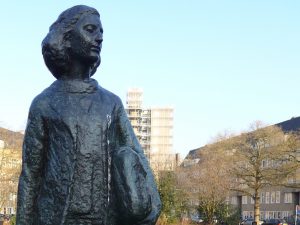
Med Heasche Beddie voo Owenglie hodd alles oogefangge: Mir huh 2017 ’s Haus ean Amsderdam gefonne, wu se med ihrm Kall, der voo Frankfoadd woar, on ihrm Sohn Alfred gewuhnd hadd. Dè Kall eas 1940 geschdorwe, die Beddie on dè Alfred sai voo dè Naadsies imgebroachd worrn. Mir winn o se on oo ville annern erinnern: Insenn Geschechdsveräi mächd è Geschechdswiergschdoadd eam Mirds ean Breme, on mir loare dèzu ean. Ech schdell dè gefaldede Zärrel hie ean dè Blog, on fier die, die’s käi Doidsch geläse kenn, huh ech’s ewwersassd. Mit Betty Baer, geborene Sondheim aus Ober-Gleen, hat alles angefangen: Wir haben 2017 das Haus in Amsterdam Zuid gefunden, wo sie mit ihrem Mann Karl, der aus Frankfurt am Main war, und ihrem Sohn Alfred gewohnt hatte. Karl Baer ist 1940 gestorben, Betty und Alfred sind von den Nazis umgebracht worden. Wir wollen an sie und an viele andere erinnern: Unser Geschichtsverein veranstaltet eine Geschichtswerkstatt in Bremen, und wir laden dazu ein. Ich stelle den Flyer hier in den Blog, und für diejenigen, die ihn nicht lesen können, habe ich’s übersetzt. It all started with Betty Baer nee Sondheim of Ober-Gleen: In 2017, we have found the house in Amsterdam Zuid, the place where she had lived with her husband Karl Baer from Frankfurt and her Sohn Alfred. Karl has died in 1940, Betty and Alfred have been murdered by the Nazis. We wish to have them remembered, together with many others: Our historical society organises a history workshop in Bremen in March. I put the flyer in the blog and will translate it for those who don’t understand German.
Best wishes, alles Gurre, alles Gute,
Pauls Monika
About the flyer: The photo left on top shows the Anne Frank statue in the Southern part of Amsterdam, called Amsterdam Zuid or Rivierenbuurt (Riverquarter – the streets are named after rivers). This quarter was built in 1929, and many refugies from all parts of Germany, Austria, Czechoslovakia and Poland moved into the flats from about that time on. Like Family Frank from Frankfurt/Main who lived in Merwedeplein – where Anne’s statue is standing. In a bookshop around the corner that Gert-Jan Jimmink runs today, Otto Frank had bought the diary for his younger daughter. The photographer Annemie Huitzing from Bavaria lived in one of the streets and made portraits of Jewish refugees. Miriam Keesing, a musician, has done research concerning young refugees who were alone in Amsterdam. And there were old people who had hesitated to leave their homeland, families and singles. They all were neighbours in the Rivierenbuurt. And safe at least until the German Wehrmacht marched in.
Our historical association Lastoria has started the project “Germany on the Run” in 2016, asking who these people had been, who had helped them, what became of them. We are in contact by now with people who do research in the Netherlands as well as in Germany. We have attented a ceremony in a former Jewish school in Amsterdam, and wish to help combining the informations that have been gathered here and there. Considering the discussions about refugees today, we wish to remind us all to the refugees of the NS-time. When we did our very first research connected to the varieté theatre “Astoria” in Bremen, we have learnt about the exile of Olga Irén Fröhlich from Hamburg who had emigrated to Swizzerland and had lived in Bremen after the war. Human rights are one of the main topics in all of our projects, and today very much so.
We invite everyone to join in. One by one, we plan to publish the results of our voluntary research. And we want to encourage others to compare their results with others, in Germany and other countries, to share their material for example with Joods Monument (website), Alemannia Judaica (website) and Stolperstein websites. Events are possible, local regional, German wide or international meetings, school projects and more as soon as people are connected. The history workshop is to inspire that.
Why Amsterdam Zuid? We had to focus on a part of Amsterdam as there were so many people searching refuge from the Nazis. One of them appeared to have been Betty Baer nee Sondheim from Ober-Gleen, my homevillage. She had been in Amsterdam Zuid with her husband Karl and her son Alfred. We have described her fate in one of our books and in the audio book “Jiddish life”, among with many others. Why Germany on the Run (Deutschland auf der Flucht)? Werner Deutschland from Bremen-Hemelingen gave the project its name. On Joods Monument he is one of more than 104 000. And there is another Werner Deutschland, from Berlin, who has survived in Bruxelles.
“Deutschland auf der Flucht” is an open history workshop with results to be presented. Some have been documented on my website, in German and English (www.monikafelsing.de, Projekte – Amsterdam – mehr (more)). I am the one who takes care of the project and does the research.
In the Villa ichon, there will be speeches (about our research, for example, about Jewish refugees in Amsterdam, about the people the photographer had portrayed and who had survived, about Stolpersteine in Bremen connected to Amsterdam), we will present a music videoclip that has been made in Bremen in 2011 by Paul Lindsay and Alasdair Jardine. We will sing Jewish songs together, as culture is a home, as well, language and music especially. And we will learn bits of the Dutch language, and hear about the project “Aus den Akten auf die Bühne” of Bremen University. History students do research in the archives, and actors of the Shakespeare Company read them on stage. Like in the evening about the conference of Evian and the “St. Louis”. Who wants to will be able to attend a walk to some of the Stolpersteine in Bremen, or on a new audiowalk about family Rosenberg, and we will read from the biographies of Child Survivors.